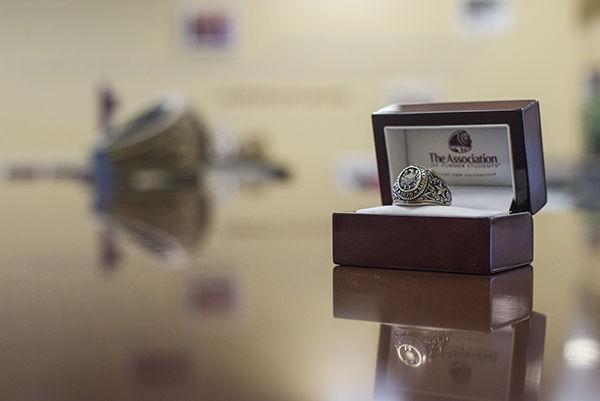Thousands of student will wear their hard-won Aggie Rings for the first time Friday. However, for a few students, those rings won’t be gold.
Silver rings have been offered by the university since the early 70s as an alternative option to the standard gold ring. Kathryn Greenwade, vice president of the Association of Former Students, said they began offering the rings, made of a mix of sterling silver and palladium called Polara, to accommodate students who were not able to get a gold ring.
“There were individuals that had restrictions within their religion that would not allow them to wear gold, so we didn’t want that to be an impediment to them having an Aggie Ring,” Greenwade said. “There were, in some rare cases, allergies where they could not wear gold. It also provides a lower cost option.”
While a typical male gold ring costs around $1,000, Greenwade said the Polara option comes in at around $300. Steven Anderson, Class of 2011, said the cheaper cost of the silver ring was the only thing that allowed him to get a ring at all, and that he has no regrets about choosing the Polara instead of the gold.
“It was because I had to pay for my ring myself, and it was a good deal cheaper than the gold,” Anderson said. “Honestly though, after having it for a few years now, I really do almost prefer it to the gold ring.”
About 2.8 percent of the rings handed out Friday on Texas A&M campuses will be made of Polara. Greenwade said the difference in cost between the gold and Polara options is larger for male rings and as such, most of those ordering Polara rings are men. However, the Association of Former Students does not feature the Polara on its website, citing an extremely low demand for both Polara and white gold rings.
Greenwade said all Aggies should be able to order a ring that fits their personal and religious standards, and that she has seen Polara Aggie Rings from across the decades.
“We want people to be able to wear their Aggie rings and be proud of it,” Greenwade said. “We want it to be something that fits within the standards of religious practices as well as personal preference. I’ve seen the ring in white gold or Polara on the hands of Aggies who are class of 2013 and ’78.”
Anderson said the response to his Polara ring has been mostly positive, although some don’t immediately recognize it as an Aggie Ring.
“A lot of times when people do notice it, the first thing they ask is if it is just super tarnished. Most of the responses I’ve had is that people like it a lot,” Anderson said. “And that may be simply because it’s different than the gold.”
Anderson said he was grateful that the option of a cheaper ring was available, because it allowed him to purchase one much sooner than he would have been able to.
“If they hadn’t had that option, I would have had to wait a significant amount of time in order to save up enough money to afford the gold version,” Anderson said. “I really love it because it’s an indication that I went to Texas A&M, that I made it through and got my degree. It’s recognizable to other Aggies. Aggies look at your hand when they shake, looking for that ring.”
All that glitters isn’t gold on Ring Day
November 6, 2014

Tanner Garza — THE BATTALION
Polara rings cost about 70 percent less than the typical male Aggie ring.
0
Donate to The Battalion
$2790
$5000
Contributed
Our Goal
Your donation will support the student journalists of Texas A&M University - College Station. Your contribution will allow us to purchase equipment and cover our annual website hosting costs, in addition to paying freelance staffers for their work, travel costs for coverage and more!
More to Discover









